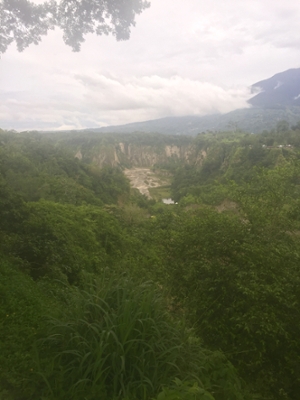Bukit Tinggi
This week has been by far my best week since arriving in Indonesia. I traveled from Padang to Bukit Tinggi with my friend and co-worker Ikhsan to celebrate Lebaran. Ikhsan graciously invited me to stay at his family’s home, and his four brothers also made the trip home to celebrate the holiday and also Ikshan’s engagement. The engagement celebration in Indonesia involves both families for the bride-to-be and groom-to-be. The ceremony also involves men from both families and the head of each tribe discussing the unification of the two families and the date of the actual wedding. A feast of delicious local foods follows this discussion. It was an amazing experience to see the engagement process, as it is quite different from the surprise proposals that are customary in the U.S. I was also able to participate in the end of Ramadan and the beginning of Lebaran. On June 15th, Ramadan officially ended in Indonesia and Lebaran began. The celebration starts with a prayer, with hundreds gathering to pray together. This is followed by an all day feast that dwarfs any Thanksgiving dinner I have had. This is because they start eating around 11 am, and then go to as many as five different family homes for more full sized meals.
Bukit Tinggi, which translates to “high cliff”, is best known for tourism. It sits directly next to two mountains, one of which is a volcano. It also offers breathtaking views of a canyon, which runs throughout West Sumatra. The first picture at the bottom of the blog is of the canyon from one of the popular viewpoints. Next to the canyon is a war tunnel that the Japanese soldiers forced the local people to build during WWII. For the locals, this tunnel is very spooky as thousands died during its construction, but the bodies have never been located. For me, it was an amazing opportunity to see a piece of history that I grew up fascinated by. As a kid, WWII was one of my favorite topics to learn about in school and on my own, so to tour through an actual Japanese WWII tunnel made so many of the things I used to read about come to life. The second picture at the bottom of the blog is the inside of the tunnel, which is now illuminated for tourists. The final picture at the bottom the blog is of the clock tower, which is the central point of Bukit Tinggi. The Dutch forced the locals to build this tower during their colonization, but it still serves as the most important landmark for the locals today. According to the locals, this clock and Big Ben in London are the only two clock towers in the world that feature a unique number four. Instead of the roman numeral “IV”, the clock features “IIII” to mark four o’clock. There was also a local law that regulated that no building could be taller than the tower. I could not help but draw a parallel to the historical law in Philadelphia, which regulated that no building could be taller than the statute of William Penn at the top of city hall.
Historically, Bukit Tunggi was a popular destination for western tourists. In fact, Ikhsan and one of his four brothers learned how to speak English by being a tour guide as a kid. However, the western tourism in Bukit Tinggi has largely decreased in recent years following the Bali Bombings. The town is still a popular destination for Indonesian tourists as it offers the landmarks described above, a zoo, and much cooler weather than many other cities in Indonesia. The town has been very busy for Lebaran, and the local markets around the clock tower constantly buzz with activity.
Because Bukit Tinggi caters to tourism, there are also several local pubs where I have been able to enjoy a local beer and watch the World Cup with many locals. Futbol is by far the most popular sport in Indonesia, and I have made some friends watching the games despite an ongoing language barrier. However, you do not need to know the same language in order to understand that England’s goal in extra time against Tunisia was incredible or that Brazil tying their first match against the Swiss was a let down for one of the favorites to win the Cup.


